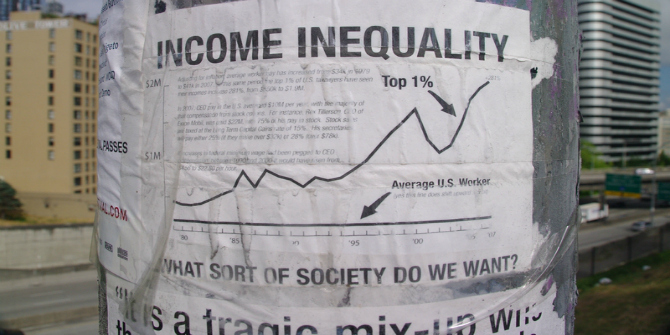In Visions of Inequality, Branko Milanovic examines how major economic thinkers in the past two centuries – from Smith and Marx to Kuznets – have conceptualised and engaged with inequality. Aleksandr V Gevorkyan finds the book a groundbreaking and essential contribution to the history of economic thought and inequalities studies.
Branko Milanovic will launch the book at a public LSE event on Thursday 30 May – find details on how to attend.
 Ideas matter. In (and for) economics, informed and transparent discussions around ideas, connected with history matter even more. This is why Branko Milanovic’s latest monograph Visions of Inequality: From the French Revolution to the End of the Cold War, centred around idea of “the evolution of thinking about economic inequality over the past two centuries,” is a work of art in today’s economics. With equal intensity, the book traverses contemporary ideological, political, and social divides and implores theoretical and empirical economists to critically assess their intellectual positions.
Ideas matter. In (and for) economics, informed and transparent discussions around ideas, connected with history matter even more. This is why Branko Milanovic’s latest monograph Visions of Inequality: From the French Revolution to the End of the Cold War, centred around idea of “the evolution of thinking about economic inequality over the past two centuries,” is a work of art in today’s economics. With equal intensity, the book traverses contemporary ideological, political, and social divides and implores theoretical and empirical economists to critically assess their intellectual positions.
Counterintuitively, economics, a social science that is inherently dynamic, is often sceptical about ideas challenging the established postulates.
Counterintuitively, economics, a social science that is inherently dynamic, is often sceptical about ideas challenging the established postulates. In a utility-maximising individualist model the role of the official state is minimal. The self-correcting market is assumed to be stable and capable of resolving questions of income distribution. On the ground, though, income and wealth distribution, access to education and healthcare and more seem to be following a different course, creating massive gaps between what Milanovic referred to elsewhere as “the haves and have-nots.”
Inequality is a historically systemic issue holding hostage the prosperity of the present and the sustainability of the future. Milanovic is convinced that the key determinants of inequality are embedded in the bedrock of an economic system (rather than defined by individual choices) as he leads us on the chronological analysis in his book. And yet, the idea of connecting the various concrete manifestations of inequality of everyday life with theoretical thinking motivating tangible economic policy measures has not been a staple of contemporary economics. “Serious economics” avoided “harmful to sound economics” inequality, centring, instead, on broad economic growth. Growth is essential, but, as Milanovic argues, so is an open conversation on the ideas or “visions” around inequality.
Milanovic is convinced that the key determinants of inequality are embedded in the bedrock of an economic system (rather than defined by individual choices)
It seems that economic inequality stormed into our globalised society around the 2008 Global Financial Crisis, which impoverished millions and was a watershed moment for economics. Almost immediately economists began to question the wisdom of their rational models and began generating new methodological blueprints from a long menu of ideas, from economic cycles, the effectiveness of proactive state and central banks in steering growth, to the role of credit in the global economy and more. Amidst declining living standards, notably across middle-income groups of the advanced economies, a vast number of studies on inequality began to appear, adding to earlier work of such authors as Tony Atkinson, Thomas Piketty and Emmanuel Saez, among others.
Almost two decades before the 2008 crisis, Milanovic had nearly single-handedly advanced the study of income inequality from an intellectual curiosity into a central topic in empirical economics research and development policy agendas. This comes through his early work on the post-socialist economies of Central and Eastern Europe and former Soviet Union and during his tenure as the lead economist in the World Bank’s Research Department.
In this new book, Milanovic, acknowledging the profession’s scepticism towards inequality, stands with the worldly philosophers of early capitalism who were aware of the sharp contrasts in social and economic outcomes. Georg Hegel’s 1820 commentary on the rapidly deepening rich and poor social and economic gap and possible antidotes are still relevant today. Henry George saw the same systemic social and economic divide of his time as the tragedy that overshadowed the industrial progress. It is in this wider context that a reader might gain the most from Visions of Inequality. The book’s unique contribution is a deftly managed balance between the structure (seven chapters tracking prominent economists’ engagement with inequality from the past two centuries) and the depth of thematic discussions.
Milanovic […] stands with the worldly philosophers of early capitalism who were aware of the sharp contrasts in social and economic outcomes
The first six chapters explore the economic inequality perspectives of Francois Quesnay, Adam Smith, David Ricardo, Karl Marx, Vilfredo Pareto and Simon Kuznets, respectively. The discussions in each chapter are interconnected and build upon each other, leading us to the concluding seventh and longest chapter which synthesises more recent developments in inequality discourses and the contributions of present-day economists. It largely focuses on the attention inequality received during the Cold War when the capitalist economic and political system existed in contrast to the socialist system (before capitalism gained full supremacy, the topic of Milanovic’s Capitalism, Alone). This last chapter – the book’s crescendo – is also where he expounds his critique of mainstream neoclassical economics. Here, he takes aim at the omission of global power relations and inequality in standard economics. The chapter, with its expansive discussions on contemporary political economy and the relevance of economics as a social science, could easily be studied separately.
Three important observations from the book stand out. Firstly, Milanovic’s deep critical engagement with the works of the classical economists, rather than reliance on subsequent interpretations of these texts, is commendable. The author reads the original works thoroughly and with specific attention to inequality, showing how some ideas in economics, albeit unpopular or discredited by the majority, have played a role in developing the general thinking of the classical economists. His approach embodies the value of studying two, interrelated, but separate fields: economic history and the history of economic thought. There is just no economics to speak of without this duo.
Secondly, Milanovic emphasises that each of the classical economists surveyed in his book referred to the questions of inequality from the viewpoint of the historical period and economic system of their time. It is in this historical understanding of economics where he effectively merges empirical narrative with underlying theory to produce a convincing picture of an economic system in its historical continuum. Much of contemporary economic research seems to be over-reliant on technical data analyses, severed from the historical determinants. That separation often creates a fatal mismatch between economic theorising and actual economic policy design and implementation, an experience that many, especially small, post-socialist transition economies have passed through and are still living.
Much of contemporary economic research seems to be over-reliant on technical data analyses, severed from the historical determinants. That separation often creates a fatal mismatch between economic theorising and actual economic policy design and implementation
For Milanovic, the evolution of our views on inequality is deeply rooted in our history. If the political economists of the 18th and 19th centuries viewed the economic outcomes from the perspectives of evolving class structures of their societies (from Quesnay, to Smith, Ricardo and Marx), then the 20th century economists like Kuznets saw inequality as a product of the development of industrial forces, growth in manufacturing, technological advancement, and urbanisation. This would have effects also in terms of degree of attention that each author would attribute to inequality as a socio-economic problem in their vision of political economy system but also in any designs for distributional policy or taxation regulation. Learning from those experiences is paramount to properly understanding of the intensity the contemporary situation.
Thirdly, the book deconstructs some of the mainstream interpretations of the classical economists’ teachings. For example, Milanovic’s nuanced reading of Adam Smith interprets him as today’s “leftist economist”, arguing that Smith’s concern with fair outcomes in, what we now call the market, and his concern about concentration of wealth and monopolisation of entire industries is one of the crucial thoughts in Smith’s The Wealth of Nations.
Milanovic is encouraged by the rising volume and intellectual depth of work in inequality studies, the connections between different topics and the exploration of different types of inequalities.
The book’s conclusion is hopeful. Milanovic is encouraged by the rising volume and intellectual depth of work in inequality studies, the connections between different topics and the exploration of different types of inequalities. The growing availability and access to data like The Stone Center on Socio-Economic Inequality with which the author is affiliated or through the World Inequality Database is enabling a new generation of economists to undertake empirically more informed and conceptually more advanced research that can in turn inform policymaking.
It would be interesting to see Milanovic continue with his research, perhaps adding analysis of works by more economists. The book could also be adapted for less specialist audiences, engaging with fields outside of economics and with public policy. As it stands, Visions of Inequality is an essential and insightful analysis of the history of economic inequality urgently relevant today. It is a comprehensive study into wider economic history and the history of economic thought through the lens of inequality. As such, it is a groundbreaking work, bound to influence the economics profession and our worldview.
Note: This review gives the views of the author, and not the position of the LSE Review of Books blog, or of the London School of Economics and Political Science.
Image credit: “Lazarus at the Rich Man’s Gate” by Heinrich Aldegrever. Public Domain, Met Museum collection.








1 Comments